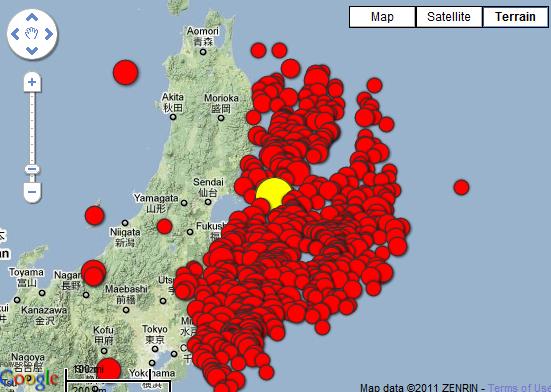
Hundreds of Aftershocks: Will Japan Ever Stop Shaking?

In an amazing burst of seismic activity, Japan has felt hundreds of earthquakes since March 11, when a magnitude 9.0 quake triggered a tsunami that killed thousands of people and damaged some nuclear reactors.
Such seemingly rapid-fire quakes are called aftershocks a series of smaller quakes that follow the largest quake in what is generally a steadily decreasing sequence, according to the U.S. Geological Survey.
Since the main quake off Japan's northeastern coast, hundreds of magnitude 5 aftershocks and dozens of magnitude 6 aftershocks have struck the island of Honshu, Japan's largest and home to 100 million people. The largest aftershock was a magnitude 7.9 that struck less than an hour after the main shock.
These may seem like a lot of aftershocks, but the number and size are not considered odd for what now ranks as the fourth largest earthquake ever recorded .
"Every earthquake has aftershocks. Bigger earthquakes just have more," said Morgan Page, a geophysicist with the USGS in Pasadena, Calif.
Sendai aftershocks
After a large earthquake, tectonic plates the huge slabs of the Earth's crust that bang together to cause the original quake continue to readjust the stress along a fault, which triggers aftershocks.
Sign up for the Live Science daily newsletter now
Get the world’s most fascinating discoveries delivered straight to your inbox.
Regions near Sendai, about 80 miles (130 km) west of the quake's epicenter, may feel aftershocks from the Tohoku quake for some time, according to the USGS, but their exact location and timing are unpredictable.
The number of aftershocks will continue to be highest on and near to the parts of the fault that ruptured during the magnitude 9.0 quake, according to the USGS. Farther away, aftershocks become less and less likely, Page said.
The aftershock hazard also lessens with time, Page said. A year from now, the number of aftershocks in Sendai will be a fraction of what they were right after the main quake although, based on a magnitude 9.0 quake, they will still rate a detectable number.
"This aftershock sequence will continue for years, even decades," Page said.
Aftershocks of aftershocks
Even as the aftershocks become less common, big ones could still strike. Chile saw this firsthand when a 6.6-magnitude aftershock ruptured near Maule in February, almost a year after what is now the sixth-largest earthquake in recorded history, magnitude 8.8, hit the same region.
Every aftershock of the magnitude 9.0 earthquake will itself have aftershocks. Then all of those aftershocks will have aftershocks, and the pattern will continue.
The rule of thumb for seismologists is that an aftershock will be about a magnitude of 1 lower than the main shock, said Ken Hudnut of the USGS.
Page also said a magnitude 9.0 earthquake will average 10 times as many aftershocks as a magnitude 8.0, which will have 10 times as many aftershocks as a magnitude 7.0, and so on.
"Luckily each generation of aftershocks has far fewer earthquakes than the previous generation (provided a very large aftershock does not occur), so that the sequence will eventually die out," Page said.
Ring of Fire
The probability of future major earthquakes has not been significantly raised by the one in Japan, the USGS said in a statement.
Yet that probability hasn't decreased, either. Large earthquakes have struck along the Pacific Ring of Fire, along which Japan sits, in the past and will continue to do so in the future.
The Pacific Ring of Fire is a narrow zone around the Pacific Ocean where a large chunk of Earth's earthquakes and volcanic eruptions occurs. Roughly 90 percent of all the world's earthquakes and 80 percent of the largest ones strike along the Ring of Fire.
Tokyo at risk?
An apparent southward migration of aftershocks following Japan's magnitude 9.0 quake has prompted fears about seismic activity creeping toward Tokyo, with the aftershocks possibly increasing that megacity's quake risk .
One concern is based on a magnitude 6.2 aftershock that hit just west of Tokyo outside the zone where most of the aftershocks from March 11 ruptured. But this was not the only aftershock to occur outside the main cluster, and it's not usual to have a few aftershocks somewhat far away.
"I am quite skeptical of apparent migration of aftershocks to the southwest," Page said. "I don't see it in the aftershock map."
- Video: Japan Before the Tsunami and After
- In Pictures: Japan Earthquake and Tsunami
- Japan's Explosive Geology Explained
Email OurAmazingPlanet staff writer Brett Israel at bisrael@techmedianetwork.com. Follow him on Twitter @btisrael.









